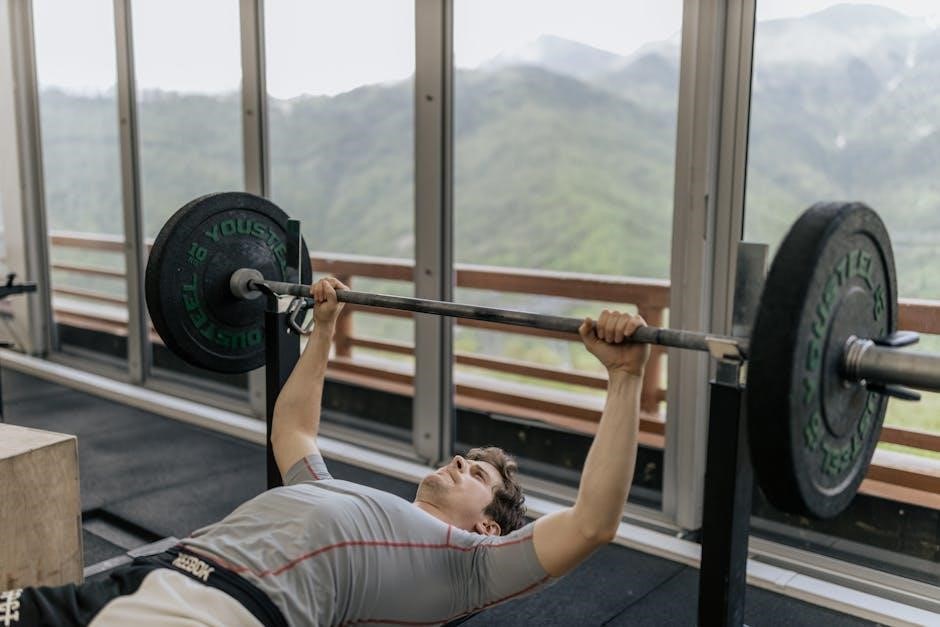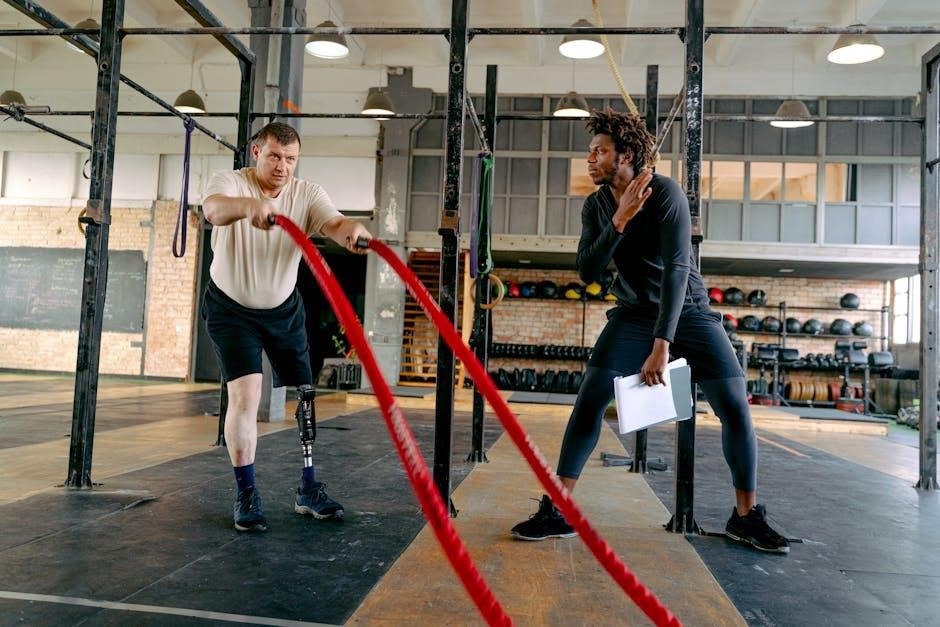Mastering the 800-meter event requires a blend of endurance, speed, and race strategy. This section introduces key concepts and the importance of a structured training program for success.
1.1 Understanding the 800 Meter Event
The 800-meter race demands a balance of endurance and speed, making it a true test of aerobic and anaerobic capacity. Athletes are categorized into types based on their strengths—some excel in sprinting, others in endurance. Training programs are tailored to these types, often featuring speed intervals, tempo runs, and periodized plans to optimize performance. Understanding one’s athlete type and implementing a structured approach are key to achieving success in this event.
1.2 Importance of a Structured Training Program
A well-structured training program is essential for maximizing performance in the 800-meter event. It ensures a systematic approach to building endurance, speed, and race-specific skills. Periodization helps prevent overtraining by alternating intense and recovery periods, allowing the body to adapt effectively. A structured plan also promotes consistency and progressive overload, which are critical for achieving peak performance. Without a clear plan, athletes risk plateaus or injuries, making a structured program indispensable for success.

Components of an Effective 800 Meter Training Program
An effective 800-meter program combines endurance, speed, and race-specific workouts. It includes flexibility, strength training, and periodization to optimize performance and prevent injuries. Consistency and recovery are key.
2.1 Base Building and Endurance Training
Base building and endurance training form the foundation of an 800-meter program. This phase focuses on developing aerobic capacity, increasing stamina, and enhancing lactate threshold. Long runs, tempo runs, and interval workouts are essential. Consistency in training helps improve cardiovascular health and muscular endurance. Incorporating progressive overload ensures gradual adaptation. Recovery and nutrition are critical to avoid burnout. This phase prepares athletes for more intense workouts later in the program, ensuring a solid endurance base for race-specific demands.
2.2 Speed and Power Development
Speed and power development are crucial for 800-meter athletes to enhance acceleration and maintain velocity. This phase incorporates sprint intervals, hill repeats, and plyometric exercises to build explosive force. Focused workouts like 200-meter repeats and short sprints improve neuromuscular coordination and running efficiency. Strength training, such as weightlifting and resistance exercises, complements on-track efforts by increasing power output. Balancing speed and endurance ensures athletes can sustain fast paces throughout the race, making this phase vital for competitive performance.
2.3 Race-Specific Workouts
Race-specific workouts are designed to mimic the demands of the 800-meter event, focusing on race-pace runs, time trials, and simulated race conditions. These sessions help athletes adapt to the physical and mental stresses of competition. Examples include 400-meter repeats at race pace, tempo runs, and pro/anti gravity workouts. These exercises enhance race-specific endurance, pacing accuracy, and mental toughness, ensuring athletes are prepared to execute their race strategy effectively on competition day.
2.4 Flexibility and Mobility Exercises
Flexibility and mobility exercises are essential for maintaining optimal range of motion and reducing injury risk. Dynamic stretches, such as leg swings and high knees, prepare the body for training. Static stretches target tight muscle groups like hamstrings and hip flexors. Mobility drills, including calf raises and hip circles, improve joint mobility. Incorporating foam rolling and yoga can enhance recovery and overall flexibility. Regular practice ensures athletes maintain proper movement patterns, reducing muscle tightness and improving performance during intense workouts;
2.5 Strength and Core Training
Strength and core training are vital for 800-meter runners, enhancing power, stability, and endurance. Exercises like squats, lunges, and plyometrics improve lower body strength and explosiveness. Core workouts, such as planks and Russian twists, strengthen abdominal muscles, improving posture and stability. These exercises reduce injury risk and enhance overall athletic performance. Incorporating resistance bands and weightlifting can further build muscular endurance. A well-rounded strength program supports faster times and sustained energy levels during races, making it a cornerstone of successful 800-meter training.

Sample 12-Week Training Program
This structured 12-week program gradually builds endurance, speed, and race-specific skills. Weeks 1-4 focus on foundational endurance and basic speed work. Weeks 5-8 increase intensity with race-specific workouts. Weeks 9-12 emphasize race preparation, including tapering and strategy refinement, ensuring peak performance on race day. Each phase is designed to progressively enhance fitness and race readiness, culminating in optimal performance for the 800-meter event.
3.1 Week 1-4: Building the Foundation
Weeks 1-4 focus on establishing a strong aerobic base and foundational speed. Workouts include long endurance runs, tempo runs, and introductory speed intervals. Incorporate strength training and mobility exercises to enhance running efficiency and prevent injuries. Gradually increase mileage and intensity to build resilience. Emphasize consistent pacing and proper recovery to support adaptation. This phase lays the groundwork for more intense training in subsequent weeks, ensuring a solid foundation for race-specific preparation. Balance is key to avoid overtraining while building endurance and speed.
3.2 Week 5-8: Increasing Intensity
Weeks 5-8 shift focus to building speed and lactate threshold through higher-intensity workouts. Incorporate interval training, such as 400m and 200m repeats, at race pace. Tempo runs and hill sprints enhance endurance and power. Strength and core exercises remain crucial to support increased demands. Gradually reduce recovery time between intervals to simulate race conditions. Proper pacing and form are emphasized to optimize performance. This phase prepares athletes for the demands of race-specific training while maintaining a balance between intensity and recovery to avoid burnout.
3.3 Week 9-12: Race-Specific Preparation
Weeks 9-12 focus on race-specific preparation, simulating competition conditions. Workouts include race-pace runs, time trials, and strategy sessions to refine pacing and mental toughness. Tapering begins to ensure peak performance, with reduced volume but maintained intensity. Athletes practice race-day routines, such as warm-ups and cool-downs. Strength and mobility exercises remain essential to prevent injury. The goal is to fine-tune race readiness, allowing athletes to enter the event mentally sharp and physically prepared for their best performance.

Progression and Periodization
Progression and periodization are key to optimizing performance. Periodization involves organizing training into phases with specific goals, while progression ensures gradual increases in intensity and volume to avoid plateaus and overtraining.
4.1 Periodization Strategies
Periodization strategies divide the training cycle into specific phases, each targeting different aspects of performance. This approach ensures athletes peak for major competitions. Common periodization methods include macrocycles, mesocycles, and microcycles. Macrocycles span several months, focusing on building endurance and strength. Mesocycles last weeks to months, intensifying speed and power. Microcycles are short-term, refining race-specific skills. Incorporating recovery weeks every 4-6 weeks prevents overtraining and allows adaptation. This structured approach maximizes athletic development and performance, ensuring athletes are competition-ready when it matters most.
4.2 Gradually Increasing Workload
A well-structured training program incorporates gradual increases in workload to enhance performance and prevent overtraining. Athletes should progressively intensify their training by adjusting the volume, intensity, or frequency of workouts. This approach allows the body to adapt and strengthens both endurance and speed. Monitoring progress and listening to the body ensures safe and effective advancement. Recovery weeks are essential to avoid burnout and enable physiological adaptation. A balanced increase in workload helps athletes achieve peak performance without risking injury or mental fatigue.

Nutrition and Recovery
Nutrition and recovery are critical for optimal performance. Proper fueling with balanced carbs, proteins, and fats supports energy needs. Hydration and recovery techniques like stretching and sleep enhance adaptation and reduce injury risk.
5.1 Fueling for Performance
A well-balanced diet is essential for 800-meter athletes, providing the energy needed for intense training and recovery. Focus on complex carbohydrates for sustained energy, lean proteins for muscle repair, and healthy fats for overall health. Hydration is critical, with water and electrolytes maintaining performance levels. Timing meals around workouts ensures optimal energy availability. Avoid heavy meals before training and prioritize post-workout nutrition to replenish glycogen stores and aid recovery. Tailoring nutrition to individual needs and training phases maximizes performance and supports long-term consistency.
5.2 Recovery Techniques
Effective recovery is crucial for optimal performance in 800-meter training. Techniques include foam rolling, stretching, and ice baths to reduce muscle soreness. Compression garments and elevation can enhance blood flow and aid recovery. Sleep is vital, with 7-9 hours recommended for physical repair. Active recovery, such as light jogging or cycling, promotes blood circulation without overexertion. Consistency in these practices helps prevent injuries and ensures the body adapts to the demands of training, ultimately improving race performance and overall success.

Mental Preparation
Mental preparation is vital for 800-meter success. Techniques like visualization, positive affirmations, and breathing exercises help build resilience and focus. Developing a race strategy and confidence in abilities ensures athletes stay composed under pressure, optimizing performance and achieving their goals.
6.1 Building Race Confidence
Building race confidence involves mental strategies like visualization, positive self-talk, and reviewing past successes. Setting realistic goals and learning from failures fosters resilience. Consistent training and preparation reinforce belief in one’s abilities. Focus on controllable factors, such as effort and execution, rather than outcomes. Cultivating a growth mindset helps athletes embrace challenges as opportunities to improve. Over time, these practices create a strong mental foundation, enabling runners to perform at their best and stay focused during high-pressure races.
6.2 Race Strategy and Tactics
Effective race strategy in the 800 meters involves positioning, pacing, and tactical decisions. Athletes should aim for a strong start to secure a favorable position, avoiding being boxed in. They can employ tactics like surging mid-race to gain an advantage. Proper pacing ensures energy conservation for a powerful finish. The final sprint should be timed precisely to maximize speed. These strategies should be personalized to align with the runner’s strengths, race goals, and fitness level, ensuring optimal performance.

Avoiding Injuries
Avoiding injuries requires proper warm-ups, cool-downs, and gradual progression in training. Incorporate strength exercises to build resilience and listen to your body to prevent overtraining.
7.1 Common Injuries in 800 Meter Training
Common injuries in 800-meter training include shin splints, runner’s knee, hamstring strains, Achilles tendinitis, and stress fractures. These often arise from overtraining, poor form, or insufficient recovery. Shin splints are frequent due to repetitive stress on the lower legs, while runner’s knee and Achilles issues stem from improper footwear or biomechanics. Hamstring strains occur from sudden sprints or inadequate warm-ups. Stress fractures develop from excessive mileage without adequate rest. Addressing these issues early is crucial to prevent long-term setbacks and maintain consistent training progress.
7.2 Injury Prevention Exercises
Preventing injuries in 800-meter training involves targeted exercises to strengthen muscles and improve flexibility. Calf raises and heel drops strengthen the Achilles and calves. Glute bridges and side-lying leg lifts enhance hip stability. Planks and core work improve posture and reduce lower back strain. Dynamic stretches, like high knees and leg swings, prepare muscles for intense runs. Incorporating these exercises into daily routines helps build resilience and minimizes the risk of common injuries, ensuring a consistent and effective training program.

Customizing the Program
Customizing the training program involves tailoring workouts to individual needs, fitness levels, and goals. Adjusting intensity, volume, and recovery ensures optimal progress and avoids plateaus or overtraining.
8.1 Adjusting for Individual Needs

Each athlete’s needs vary based on experience, goals, and physical capabilities. Type I runners focus on speed, while Type II may excel in endurance. Training should be tailored to match individual profiles, incorporating race-specific workouts, endurance building, and strength exercises. Adjustments include modifying intensity, volume, and recovery periods. Periodization strategies help balance training phases, ensuring peak performance. Customizing the program fosters progress, prevents overtraining, and addresses specific weaknesses, ensuring a personalized approach to achieve optimal results for each runner. This adaptability is crucial for long-term success in the 800-meter event.
8.2 Modifying Workouts Based on Fitness Level
Workouts must be tailored to an athlete’s fitness level to ensure safety and effectiveness. Beginners focus on building endurance and strength, while advanced runners emphasize speed and race-specific drills. Training intensity, volume, and recovery periods are adjusted accordingly. For instance, less experienced athletes may start with longer intervals at a moderate pace, gradually increasing intensity. More seasoned runners incorporate high-intensity intervals and tempo runs. Periodization strategies help balance training phases, preventing overtraining and ensuring progressive overload. This approach fosters balanced development and sustained improvement, catering to individual capabilities and goals.
A well-structured 800-meter training program, combined with consistency and dedication, is key to achieving success. Tailor strategies to individual needs and stay committed to long-term goals.
9.1 Final Tips for Success
To excel in the 800-meter event, stay consistent with your training program and listen to your body to avoid burnout. Prioritize mental preparation and race strategy to stay focused under pressure. Incorporate flexibility and mobility exercises to maintain optimal performance. Stay hydrated, fuel your body with a balanced diet, and ensure adequate recovery. Finally, seek guidance from experienced coaches or athletes to refine your technique and gain valuable insights. With dedication and smart training, you’ll achieve peak performance and reach your goals.

Additional Resources
Explore recommended books, online tools, and forums for detailed training insights. Utilize expert guides and communities to enhance your 800-meter training program and stay updated on best practices.
10.1 Recommended Reading
For in-depth knowledge, consider reading “800 Meter Training” by R. Greenblatt, which offers practical insights and structured plans. Another excellent resource is “Advanced Running Training” by MP Malaysia, providing detailed workouts and injury prevention tips. Additionally, “The Art of Middle-Distance Running” by renowned coaches is a must-read for understanding race strategies and periodization. These books are available on major online platforms and sports libraries, ensuring accessible learning for athletes and coaches alike.
10.2 Online Tools and Communities
Utilize online platforms like ChatGPT and Gemini Advance for personalized training insights. Websites such as Runner’s World and Track & Field News offer comprehensive guides and expert advice. Join online communities like Reddit’s r/Running and Facebook running groups to connect with athletes and coaches. These resources provide access to training plans, injury prevention tips, and real-time support, helping you stay motivated and informed throughout your 800-meter journey.



